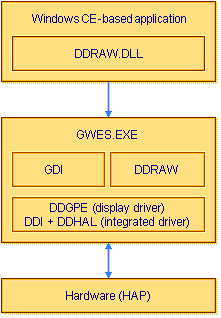 Important: Important: |
|---|
| This is retired content. This content is outdated and is no longer being maintained. It is provided as a courtesy for individuals who are still using these technologies. This content may contain URLs that were valid when originally published, but now link to sites or pages that no longer exist. |
DirectDraw on Windows CE is generally a subset of the corresponding version of DirectDraw for desktop Windows. The core DirectDraw executable code resides in a system process (gwes.exe). Applications link to a smaller client-side ddraw.dll proxy, which is responsible for maintaining remote DirectDraw COM interfaces between the system and user processes. (Windows CE, by default, does not provide for out-of-process COM servers.)
An integrated abstraction layer is used by GDI and DirectDraw components within the system process to combine the functionality of GDI/DDI and DDRAW/DDHAL with a single, integrated framework of C++ classes and functions. This layer is called the DirectDraw Graphics Primitive Engine (DDGPE). The C++ classes provided by DDGPE are extensions of the existing GPE classes, which have always been available to developers for use in their GDI display drivers for Windows CE.
Both DirectDraw and GDI link locally to the DDGPE-derived driver. A driver's DirectDraw functionality follows the desktop Windows DDHAL specification (see the Microsoft DirectDraw Hardware Abstraction Layer document). This simplifies the porting effort of existing DirectDraw DDHAL drivers to the Windows CE environment.
The following diagram, shows how DirectDraw and the display driver are integrated:

Last updated on Tuesday, July 13, 2004
© 2004 Microsoft Corporation. All rights reserved.